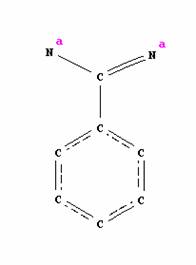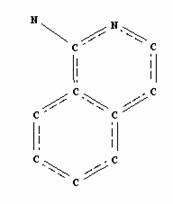A. Substructure searching in Relibase
In this part of the workshop we will cover the analysis of protein-ligand interactions and substructure searches within Relibase+.
Background
The prevention of blood coagulation is a major aim for new therapeutic agents. The serine protease factorXa (fXa) involved in the coagulation cascade has for the last decade been the subject of intense research and a number of non-peptide inhibitors have been co-crystallised and deposited in the PDB. In this exercise we will take a closer look at the inhibition of fXa and examine the different inhibitors and their interaction with the protein.
i) Substructure search. We will start with searching for a common fragment often found in protease inhibitors. This fragment, benzamidine, is known to form a strong electrostatic interaction in the S1 subpocket. Choose Sketcher and draw the structure of benzamide shown below. When you have finished drawing the structure, right click on one of the nitrogens, a menu will appear choose Cyclicity -> Acyclic, this will make sure that the nitrogen is not part of a ring. Repeat for the other nitrogen.
Note: Make use of the Templates for the phenyl ring and make sure that ligand is selected in the box below to ensure that you are only searching the ligand entries of the database. Do not include any hydrogens in your substructure.
ii) When you have finished drawing the fragment, click Search. This will bring up filter options. Leave everything at their default values and click Start.
iii) When the search is completed you will automatically be transferred to the Substructure Search Results page. The search will result in over 450 hits, indicating that the fragment is present in a large number of ligands. In the left-side panel of the browser you can scroll through the hits. Select a few at random – what kind of receptor is associated with the ligands?
iv) Many of the hits are for trypsin inhibitors, but also for Factor VII, FactorXa and thrombin. The varieties of proteases indicate that the fragment is not very selective. Indeed, many of the ligands bind to several serine proteases.
v) Go back to the Sketcher. We are now going to search for a fragment that could loosely be termed bioisoter of the benzamidine group.
vi) This time the search only retrieves 10 hits. Select the ligand corresponding to the PDB entry 1f0r, this is a FactorXa inhibitor labelled RPR208815. Open up the entry in ReliView by clicking Show in ReliView. Study the interactions between the protein and ligand. Identify the residue Asp189 by using the Protein explorer on the top left side of the ReliView window – the ‘tree’ can be expanded by clicking on the + sign next to the structure name. Asp189 is an important anchor in the S1 pocket of serine proteases.
vii) In the explore window you will see a yellow coloured side-chain. This side-chain originates from another molecule of the protein and is present due to packing effects. Packing effects are not trivial to access through the pdb database and will be absent from the pdb file if there is only one protein in the unit cell. Packing can have a large effect on ligand binding and should not be ignored. Do you think the side-chain in this example influences the conformation of the ligand?
viii) Going back to the Relibase+ page, scroll down to Water-Mediated Protein-Ligand Contacts. Two waters are shown to be important for ligand binding. Click on show for the first entry containing the two waters 12 and 170 to study these in ReliView.
This ends part 2A - Part 2B - Back to Start

